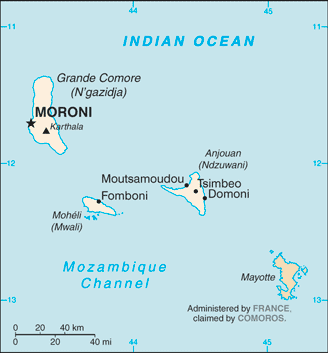Africa > Comoros: Weather, Map, Costs and Travel Guide

Comoros : When and where to go?
Click on a city for complete climate and weather tables
| Town | Jan | Feb | Mar | Apr | May | June | July | Aug | Sept | Oct | Nov | Dec |
| Moroni |  |  |  |  |  |  |  |  |  |  |  |  |
Comoros: Climate & Weather
The year is divided into two great seasons, the summer, which lasts from November to March and which is very hot with frequent showers, and the winter, between April and October, where the temperatures are milder with a dry climate , Much more pleasant: it is therefore during this period that it is necessary to visit the archipelago, especially since the risks of cyclones are mainly in February and March.
Weather today

Light Rain
Wind: 4 km/h
Precipitation forecast: 3,6 mm
> Full report and 7-days forecast
Data updated at 02:14 (local time)
At that time, the weather was:
 26 °C / Clear
26 °C / Clear
Comoros: Map

Sponsored links
What to do in Comoros
The mountains of Grande Comore are dominated by Mount Kartala, at 2,300 meters above sea level, which is an active volcano, partly covered by a pristine forest where you can go for magnificent walks, Assault of the mount in 6 hours of walk (3 possible routes).
On Mohéli, the wildest of the islands, you can leave Fomboni, the most important city, to discover the rainforest, Lake Dziani Boundouni, the castle Saint-Antoine and the many deserted beaches, all in the quietest Total, tourists being very rare on this island.
Anjouan is very populated. With its varied landscapes, the island offers many paths to discover the lakes, waterfalls and rivers: the Tatinga Falls, Lake Dzianlandzé, Lake Dzialaoutsounga, Mount Ntingui, Has a superb panorama of the archipelago, and the ylang-ylang plantation of the Bambao circus.
The beaches of the Comoros are most often made of black lava, but they can also sometimes offer an incredible white sand, especially on Grande Comore and Mohéli.
Many species, both fauna and flora, find shelter on the Comoros, and some are endemic, such as the tortoise with scales and the green turtle. Do not miss the marine reserve of Nioumadioua, south of Mohéli, try to see a big bat of Livingstone (1 meter of wingspan ... but frugivore), go to the night fell on the beach of Chissioua Quenefou where The green turtles will lay eggs, and admire by diving the famous coelacanth, fish 350 million years old!
As for the plants, the archipelago is the most important producer of ylang-ylang, and you will visit in Bambao, Anjouan, a distillery that extracts the essence. Other flowers or perfumes you will encounter en route, vanilla, jasmine, patchouli ...
Comoros: The basics
The current currency is the Comoros franc (KMF).
We land at Grande Comore at Prince Said Ibrahim International Airport, about twenty kilometers from Moroni.
To travel on the spot, one can go from one island to the other by plane, but there is not necessarily a flight every day; There are also boats which make the shuttles. If you choose to rent a car, opt for a SUV because of the state of the roads. One can also borrow collective taxis-bush, which leave only when they are full.
Health: there is no compulsory vaccination, but it is better to have, in addition to conventional vaccines, those against hepatitis A and B, and to follow an antimalarial treatment. Protection against mosquitoes must be effective, and tap water is not recommended.
Security: the archipelago is rather secure, but a certain political instability can complicate the situation. Beware of the Kartala volcano which can occasionally jerk, inquire before any excursion in this area.
Shopping: you can bring in silver jewelery, basketwork items, raffia hats, embroidered linen, carved wood, spices, vanilla, pepper, cinnamon and ylang-ylang. On the other hand, it is forbidden to buy turtles, corals and shells.



